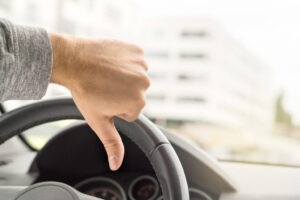
From minor fender-benders to fatal, multi-vehicle pile-ups, traffic crashes occur daily on Florida’s roads and highways. Causes might be attributed to driver-behavior, the environment, or mechanical failures, but some scenarios are more likely to cause a traffic collision than others. The consensus of organizations who study causes of collisions, including those at the federal, state, and local level, is that driver behaviors lead to the most traffic crashes. The most common cause of collisions differs among crashes resulting in fatalities and those resulting only in property damage and/or injury.
When deaths occur as a result of traffic crashes, statistics reveal speeding as the most frequent cause of those collisions. In fact, the National Highway Transportation Safety Administration (NHTSA) reports more than one out of four of all traffic fatalities and almost 17 percent of all fatal crashes in 2017 resulted from speeding. When a traffic collision does not lead to death, the most common cause is distracted driving.
Florida’s Department of Highway Safety and Motor Vehicles (FLHSMV) reports the following statistics on speeding and distracted driving in 2017, their most recent year of data:
- Speeding caused 426 fatal crashes on Florida’s roads in 2017.
- Distracted driving led to 234 fatal crashes in 2017.
- Speeding caused approximately 73,000 non-fatal traffic collisions in 2017, resulting in 1,350 debilitating injuries.
- Distracted driving caused a little under 270,000 non-fatal traffic accidents in 2017, resulting in a little more than 3,100 debilitating injuries.
When car accident victims are lucky enough to live through a severe accident, they still face serious injuries which can cause them chronic pain and other struggles for their life. Understanding more about the most common causes of fatal and non-fatal traffic collisions can help you avoid being involved in a traffic collision with a negligent driver, and might assist you in avoiding careless and negligent choices of your own that might cause harm to others when you drive. This guide provides information about why people speed, common driving distractions, and the laws and penalties associated with speeding and driving while distracted.
Getting a Speeding Citation in Florida
When you hear about someone getting a speeding ticket, you most likely assume the police caught that person exceeding the speed limit. But going too fast for conditions, even under the speed limit, can also result in a speeding citation. Florida, like most states, gives law enforcement discretion to issue a citation when they think a driver is going too fast, regardless of the posted speed limit. It’s this type of speeding which often results in severe accidents with life-threatening injuries.
Florida law states, “No person shall drive a vehicle on a highway at a speed greater than is reasonable and prudent under the conditions and having regard to the actual and potential hazards then existing,” and also provides times drivers need to reduce their speed:
- When approaching an intersection;
- When approaching a railroad crossing;
- When approaching the top of a hill;
- When traveling on a curvy or narrow highway or road;
- When heavy traffic is present;
- When pedestrians are present;
- During inclement weather; and
- When road conditions are poor.
In addition to potentially causing a severe accident, those who speed or go too fast for conditions face fines, and in the event of a fatality, might even face vehicular manslaughter charges. Speeding in road work zones results in double the fine, and those who go more than 20 miles per hour over the posted limit, or cause property damage or injury, also face steeper fines. In the rare event that a driver travels at more than 50 miles per hour or more over the posted speed limit, police officers might issue a careless or reckless driving citation.
Expect More, Receive More: Legal Support That Feels Like Family
Speeding Patterns Among Drivers
As the most common cause of fatal collisions, speeding has garnered attention from federal and state agencies and organizations that study different aspects of speeding. In recent years, the NHTSA has identified speeding patterns among drivers. Their research assumes that when drivers have control of their speed and aren’t impacted by other traffic, underlying motivations drive their choice to go too fast. The NHTSA identified four different types of speeding patterns among drivers:
- Incidental speeding. This kind of speeding refers to drivers who don’t normally speed. When they do choose to speed, they typically don’t travel much over the posted speed limit and only do so on a small number of trips. Incidental speeders also don’t speed throughout an entire trip and their speeding is often unintentional.
- Situational speeding. When drivers don’t typically speed, but on occasion display a high level of speeding within a trip, they are situational speeders. The NHTSA suspects this pattern of speeding stems from situational factors such as traffic delays, oversleeping, running late for work, school, or other obligations.
- Regular/casual speeding. This speeding pattern refers to drivers who speed quite frequently, but typically for a small part of the trips. The NHTSA attributes this pattern to systematic behaviors.
- Habitual speeding. Habitual speeders driver over the speed limit regularly and for a large portion of each trip.
As the NHTSA found patterns of speeding among drivers, they also found some common trends in the relationship between demographics and speeding. These trends include:
- Younger males and females are more likely to speed than older females in some speed ranges.
- Drivers are more likely to speed during rush hour and on the weekends.
- Drivers who engage in reckless driving and road rage are more likely to speed in some speed ranges.
- Drivers speed less when they feel influenced by others to conform to the speed limit.
Distracted Driving Violations in Florida

Additionally, Florida’s wireless communications while driving law makes using a cell phone while driving a primary offense as of July 2019. This means law enforcement can pull over and ticket drivers who they see texting while driving, whereas before the new law took effect, law enforcement could only issue a citation when they pulled a driver over for another reason.
Florida defines distracted driving as any activity which takes a person’s hands off the steering wheel, eyes away from the road, or mind away from driving, creating manual, visual, and cognitive distractions for driving. These categories, however, are not mutually exclusive. In fact, texting while driving falls under all three categories, making it the most dangerous distracted driving behavior. Other distractions which cause thousands of accidents and injuries include:
- Putting on makeup, combing hair, and other personal grooming activities
- Adjusting the radio, a GPS, climate controls, and other features in motor vehicles
- Watching another event outside of the car, often a traffic accident or stalled vehicle
- Eating and drinking in a motor vehicle
- Conversations with occupants
- Tending to passengers in the backseat, which can include children, rideshare passengers, taxi passengers
- Daydreaming
- Reaching for items in the backseat or on the floor while driving
- Watching videos on a tablet or phone
- Reading while driving
Distractions take away the ability of a driver to react to traffic, road hazards, curves, and the road in general. When they cannot react swiftly and process the road when they drive, it can lead to serious, sometimes deadly, accidents, which devastate victims and their families.
Exceptions to Distracted Driving Violations
Distracted driving violations come with some exceptions, especially regarding wireless communications. In any case, distracted driving is still dangerous and whether or not you qualify for an exception, you should avoid distractions when at all possible. Those excluded from Florida’s wireless communication while driving law includes motor vehicle operators who are:
- On duty and driving an emergency vehicle such as a police car, fire truck, or ambulance.
- Using their phone to call 911 or to report an emergency.
- Using their phone to report criminal or suspicious activity to the police.
- Receiving messages related to operating their vehicle.
- Receiving safety-related information including emergency alerts, traffic alerts, and weather alerts.
- Using a device for navigation purposes.
- Using a device that doesn’t require reading text messages.
- Operating an autonomous vehicle.
Complete a Free Case Evaluation form now
Avoiding Traffic Speed-Related and Distraction-Related Crashes
You can avoid some crashes caused by speed and distractions by following the posted speed limit, slowing down when conditions require you to do so, and avoiding common distractions. Yet, even if you drive carefully and follow all the traffic regulations, you risk being involved in a traffic accident because of the actions of other motorists. Here are some tips to help you avoid speed-related and distraction-related crashes caused by other drivers:
- When another vehicle approaches you from behind, seems to be in a hurry, and follows you too closely, always move to the right and let them speed ahead of you. On two-lane roads, this might mean moving to the shoulder. When traveling on a divided highway or interstate, this means staying in the right lane, unless you are passing.
- If you need to go slower than the posted speed limit, always stay to the right. Driving too slow can be dangerous, especially when impatient, aggressive speeders are present.
- When you notice drivers who are speeding, give them ample space. Traveling over the posted speed limit or going too fast for conditions can lead to drivers losing control, which can lead to an accident if other vehicles are too close. When you allow enough space, you can more easily avoid a crash.
- Avoiding distracted drivers is difficult because you might not always be able to tell if a driver is distracted. If you notice a driver is operating his or her vehicle at inconsistent speeds or swerving, this might be an indication the driver is distracted. Allow more space than usual or quickly pass. The same applies if you notice someone who is using a hand-held device, reaching in the front or the back of their vehicle, putting on makeup, or doing any other distracting activities.
- Help your new drivers learn about the dangers of speeding and distracted driving. Teenagers are more likely to speed and drive while distracted than any other age group. Not only can you teach your teens about driving safely, but show them. If your new drivers see you make careless choices when you drive, they will be more likely to follow in your footsteps. With less driving experience, this will likely lead to a severe or fatal accident at some point.
Immediate Steps After a Speed-Related or Distracted Driving Crash
If you sustain severe injuries in an accident, or the accident results in a fatality, Florida law entitles you to sue the at-fault driver for damages after you have filed a claim under your mandatory personal injury protection (PIP) policy and have exceeded your policy limits. In the event you are involved in a traffic collision caused by speeding or distracted driving, take the following steps to increase the likelihood of recovering damages related to the accident and your injury:
- Get medical treatment ASAP. If emergency response teams don’t immediately arrive at the scene of the accident, call 911 if you are physically able. You might feel okay, but some injuries don’t present symptoms for hours, or even longer. You need a physician to examine you and document any injuries, which will not only protect your wellbeing but will also provide evidence for your lawyer, insurance companies, and the court, in the event you need to file a personal injury claim.
- Get contact information from other drivers and witnesses. If you are physically able, gather contact information from each person at the scene. You should also get their insurance information and take note of any weather conditions, road conditions, or driver behaviors that might have led to the accident.
- Take photos. Use your cell phone to take pictures of license plates, property damage, and any visible injuries.
- Consult an attorney. A skilled personal injury attorney can evaluate your eligibility for compensation and guide you through the process of taking legal action if necessary
If you were in a reckless driving accident and want to know more about your legal right to compensation, a Fort Myers car accident lawyer can answer your questions and help you through the claims process.
Call or text (239) 334-3933 or complete a Free Case Evaluation form






